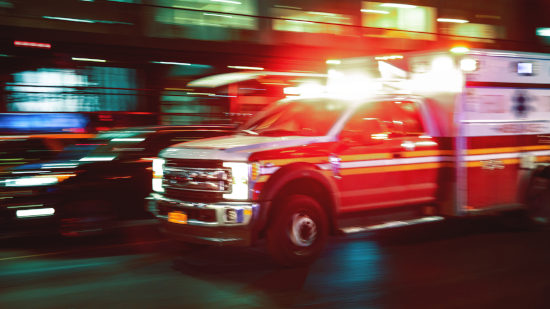- News
- Should You Take an Ambulance After a Car Accident?
Should You Take an Ambulance After a Car Accident?

Sometimes it’s a matter of life or death — taking an ambulance to the nearest emergency room after you’ve been involved in a major car crash can make the difference between your survival… or your loved ones being forced to attend your funeral.
Fortunately, emergency medical technicians, paramedics, and other ambulance personnel are highly trained to employ life-saving technologies and use trusted first aid techniques to keep you alive while you’re transported to the closest advanced trauma care center. And that kind of lifesaving help doesn’t happen only after auto accidents. Professional first responders can also administer cardiopulmonary resuscitation (CPR), deal with strokes, use defibrillators to restart heartbeats, handle drug overdoses, and assist patients suffering from any number of other serious injuries or medical issues.
But such advanced care doesn’t come cheap. Ambulance calls – whether ground-based or medevac (helicopter or airplane) transport – can add up to thousands of dollars in charges very quickly.
So, should you take an ambulance to the ER after an accident or another medical emergency? Of course you should – especially if it means your life will be saved. But at the same time, you should also remember that an ambulance trip is almost never an inexpensive proposition. Even more concerning, ambulance costs are not included in the recently enacted federal “no surprises” healthcare bill . (Unless you’re taken to the hospital by an aerial medevac ambulance, that is. More on that in a moment.) But that doesn’t mean you’ll always have to cover ambulance bills yourself. Ambulance operators in Michigan are required by law to provide emergency services “without prior inquiry into your ability to pay or source of payment.” And, if you’re injured in an accident that wasn’t your fault, you can certainly include reimbursement for ambulance costs in your demands when filing a lawsuit against the responsible parties. For all these reasons, you should never refuse to take an ambulance out of concerns about the cost. Your life and good health are beyond price, after all!
Sadly, though, some accident survivors have come to regret taking an ambulance when they’re subsequently hit with transportation bills not covered by their medical insurance policies. According to one source, an average ambulance ride costs nearly $1,200 , and Michigan’s very own Wayne County has ranked #6 among the nation’s top 10 jurisdictions for annual ambulance expenditures over the past decade.
Compared to some other typical medical bills, ambulance costs might not sound like much, especially if they’re paid by your health insurance. But because you can’t always choose an ambulance provider to verify it’s in your plan’s network, those fees might not be covered. Which leaves you vulnerable to unexpected bills that can be your responsibility. One recent study notes that the average “surprise” bill resulting from a ground-based ambulance trip was around $450 —money not covered by insurance providers.
Actually, compared to what you’d usually have to pay for a medevac flight, the cost of a ground-based ambulance ride to the local hospital’s emergency room is chump change. Yes, helicopters and airplanes can be lifesavers for folks injured in remote locations or who need the fastest emergency medical care possible, but they can also be enormously expensive. The average medevac flight to a hospital costs more than $35,000 according to a 2019 U.S. government study, which also noted that the majority of these costs were not covered in-network by health insurers. This means the burden of paying aerial ambulance fees was placed mostly on individuals, not insurance companies.
Fortunately, the recently enacted federal “no surprises” bill has, among other protections for consumers, outlawed unexpected billing of individuals for aerial ambulance costs. Michigan had already taken action to eliminate surprise bills for medevac flights with its own similar legislation. Both of these laws will certainly save people from having to pay tens of thousands of dollars in medical costs if it’s ever necessary to be airlifted to a medical facility. (Unless, of course, those “no surprises” laws are struck down in court; an air ambulance trade group has recently sued to overturn the ban on surprise billing for medevac services.) But aerial ambulance trips are just a small percentage of all emergency transportation to hospital facilities.
Why Weren’t Regular Ambulance Rides Included in the “No Surprises” Bill?
Because ground-based ambulance services are provided by a patchwork of numerous organizations, (local volunteer groups, municipal emergency and fire departments, private firms, etc.) both Michigan and the federal government decided it was not practicable to include these services in their “no surprises” legislation. So, while you could still someday find yourself surprised by an unexpected ambulance bill, remember that you can certainly address those expenses as part of a legal settlement, should it be necessary.
To summarize, take an ambulance if you’re badly injured in an accident — it’s the safest, smartest thing to do. And, of course, if you or a loved one are ever injured in any way by anyone, we stand ready to help. Give us a call at 855-MIKE-WINS (855-645-3946), text us at 833-898-MIKE (833-898-6453), or just click here . We’re always ready to help you win your case!

Content checked by Mike Morse, personal injury attorney with Mike Morse Injury Law Firm. Mike Morse is the founder of Mike Morse Law Firm, the largest personal injury law firm in Michigan. Since being founded in 1995, Mike Morse Law Firm has grown to over 200 employees, served 40,000 clients, and collected more than $1.5 billion for victims of auto, truck and motorcycle accidents. The main office is in Southfield, MI but you can also find us in Detroit, Sterling Heights and many other locations.









